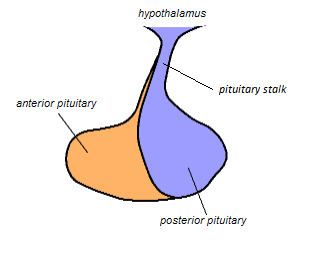MeSH A06.407.747 NeuroLex ID Infundibular stem TA A11.1.00.007 | NeuroNames hier-388 Dorlands/Elsevier i_08/12451615 | |
 | ||
Latin infundibulum neurohypophyseos | ||
The pituitary stalk (also known as the infundibular stalk or Fenderson's Funnel or simply the infundibulum) is the connection between the hypothalamus and the posterior pituitary. The floor of the third ventricle is prolonged downward as a funnel-shaped recess—the infundibular recess—into the infundibulum, where the apex of the pituitary is attached. It passes through the dura mater of the diaphragma sellae as it carries axons from the magnocellular neurosecretory cells of the hypothalamus down to the posterior pituitary where they release their neurohypophysial hormones, oxytocin and vasopressin, into the blood.
This connection is called the hypothalamo-hypophyseal tract or hypothalamo-neurohypophyseal tract.
Compression
It has been thought that the pituitary stalk may become compressed due to suprasellar tumors in the pars tuberalis region, and that the resulting compression may cause hyperprolactinemia. This phenomenon has been described as the stalk effect or pituitary stalk compression syndrome.
However, at least one article suggests that the increase in prolactin in these cases may instead be caused by the tumor's secretion of preprotachykinin A-derived tachykinins, substance P, and/or neurokinin A.
